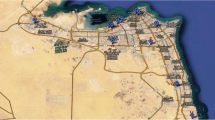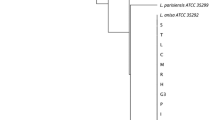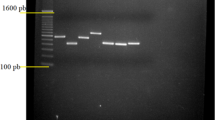Abstract
Fatty acid profile analysis, monoclonal antibody (MAb) subtyping, pulsed-field gel electrophoresis (PFGE), arbitrarily primed polymerase chain reaction (AP-PCR), and ribotyping were used to compare clinical and environmentalLegionella pneumophila serogroup 1 isolates from an outbreak of Legionnaires' disease presumptively associated with cooling towers. According to the Oxford subtyping scheme, the MAb subtype of patients' isolates and of two strains originating from a cooling tower was Pontiac, whereas the other isolates were subtype Olda. The strains showed no intrinsic strain-to-strain difference in fatty acid profiles, and ribotyping and length polymorphism of the 16S-23S rDNA intervening regions failed to reveal any differences between the isolates. Conversely, PFGE and AP-PCR appeared to be more discriminatory, as the same genomic profile was found for the clinical and some environmental strains. Meteorologic and epidemiological data and the results of molecular analysis of theLegionella pneumophila serogroup 1 isolates support the hypothesis that the infection was transmitted from one of the cooling towers to the indoor environment of the same building, to homes in proximity that had open windows, and to the streets. In fact, the outbreak diminished and later ended after a part in the tower was replaced. This investigation demonstrates the utility of combined molecular methods (i.e., phenotypic and genomic typing) in comparing epidemiologically linked clinical and environmental isolates. Finally, the outbreak confirms the risk of Legionnaires' disease posed by cooling towers, mainly when atmospheric thermal and humidity inversions occur. This finding emphasizes the need to determine whether the source of infection is in the living or working environment or somewhere else.
Similar content being viewed by others
References
Addiss DG, Davis JP, Laventure M, Wand PJ, Hutchinson MA, McKinney RM: Community-acquired Legionnaires' disease associated with a cooling tower: evidence for longer-distance transport ofLegionella pneumophila. American Journal of Epidemiology 1989, 130: 557–568.
Bartlett CLR, Macrae AD, Macfarlane JT: Environmental sources of infection and modes of transmission. In: Bartlett CLR, Macrae AD, Macfarlane JT (ed):Legionella infections. Edward Arnold, London, 1986, p. 90–119.
Bell JC, Jorm LR, Williamson M, Shaw NH, Kazandjian DL, Chiew R, Capon AG: Legionellosis linked with a hotel car park — how many were infected? Epidemiology and Infection 1996, 116: 185–192.
Bhopal RS, Fallon RJ, Buist EC, Black RJ, Urquhart JD: Proximity of the home to a cooling tower and risk of nonoutbreak Legionnaires' disease. British Medical Journal 1991, 302: 378–383.
Brundrett GW: Epidemics from cooling towers and industrial processes. In: Brundrett GW (ed):Legionella and building services. Butterworth-Heinemann, Oxford, 1992, p. 60–108.
Brundrett GW: Outbreak at Stafford District General Hospital. In: Brundrett GW (ed):Legionella and building services. Butterworth-Heinemann, Oxford, 1992, p. 109–137.
Cameron S, Roder D, Walker C, Feldheim J: Epidemiological characteristics ofLegionella infection in South Australia: implications for disease control. Australian and New Zealand Journal of Medicine 1991, 21: 65–70.
Centers for Disease Control and Prevention: Legionnaires' disease associated with cooling towers — Massachusetts, Michigan, and Rhode Island, 1993. Journal of the American Medical Association 1994, 272: 426–427.
Christopher PJ, Noonan LM, Chiew R: Epidemic of Legionnaires' disease in Wollongong. Medical Journal of Australia 1987, 147: 127–128.
Cunningham D: Broadcasting House Legionnaires' disease. Report of the Westminster Action Committee. Department of Environmental Services, Westminster Council House, London, 1988.
Hunt DA, Cartwright KA, Smith MC, Middleton J, Bartlett CLR, Lee JV, Dennis PJ, Harper D: An outbreak of Legionnaires' disease in Gloucester. Epidemiology and Infection 1991, 107: 133–141.
Muraca PW, Stout JE, Yu VL, Yee YC: Legionnaires' disease in the work environment: implications for environmental health. American Industrial Hygiene Association 1988, 49: 584–590.
O'Mahony M, Lakhani A, Stephens A, Wallace JG, Youngs ER, Harper D: Legionnaires' disease and the sickbuilding syndrome. Epidemiology and Infection 1989, 103: 285–292.
Watson JM, Mitchell E, Gabbay J, Maguire H, Boyle M, Bruce J, Tomlinson M, Lee J, Harrison TG, Uttley A, O'Mahony M, Cunningham D: Piccadilly Circus Legionnaires' disease outbreak. Journal of Public Health and Medicine 1994, 16: 341–347.
Keller DW, Hajjeh R, De Maria A Jr, Fields BS, Pruckler JM, Benson RS, Kludt PE, Lett SM, Mermel LA, Giorgio C, Breiman RF: Community outbreak of Legionnaires' disease: an investigation confirming the potential for cooling towers to transmitLegionella species. Clinical Infectious Diseases 1996, 22: 257–261.
Hlady WG, Mullen RC, Mintz CS, Shelton BG, Hopkins RS, Daikos GL: Outbreak of Legionnaires' disease linked to a decorative fountain by molecular epidemiology. American Journal of Epidemiology 1993, 138: 555–562.
Pruckler JM, Mermel LA, Benson RF, Giorgio C, Cassiday PK, Breiman RF, Whitney GC, Fields BS: Comparison ofLegionella pneumophila isolates by arbitrarily primed PCR and pulsed-field electrophoresis: analysis from seven epidemic investigations. Journal of Clinical Microbiology 1995, 33: 2872–2875.
World Health Organization: Epidemiology, prevention and control of legionellosis. Memorandum from a WHO meeting. Bulletin of the World Health Organization 1990, 68: 155–164.
Cacciapuoti B, Ciceroni L, Attard Barbini D: Fatty acid profiles in the familyLeptospiraceae. Zentralblatt für Bakteriologie 1990, 274: 16–27.
Helbig JH, Lück PC, Witzleb W: Serogroup-specific and serogroup-cross-reactive epitopes ofLegionella pneumophila. International Journal of Medical Microbiology Virology Parasitology and Infectious Diseases 1994, 282: 16–23.
Watkins ID, Tobin J O'H, Dennis PJ, Brown W, Newnham R, Kurtz JB:Legionella pneumophila serogroup 1 subgrouping by monoclonal antibodies — an epidemiological tool. Journal of Hygiene 1985, 95: 211–216.
Giovannetti L, Ventura S, Bazzicalupo M, Fani R, Materassi R: DNA restriction fingerprints analysis of the soil bacteriumAzospirillum. Journal of General Microbiology 1990, 136: 1161–1166.
Brosius J, Ullrich A, Raker MA, Gray A, Dull TJ, Gutell RR, Noller HF: Construction and fine mapping of recombinant plasmids containing therrn B ribosomal RNA operon ofEscherichia coli. Plasmid 1981, 6: 112–118.
Sambrook J, Fritsch EF, Maniatis T: Molecular cloning: a laboratory manual. Cold Spring Harbor Laboratory, Cold Spring Harbor, NY, 1989, p. 382–389.
Lück PC, Bender L, Ott M, Helbig JH, Hacker J: Analysis ofLegionella pneumophila serogroup 6 strains isolated from a hospital warm water supply over a threeyear period by using genomic long-range mapping techniques and monoclonal antibodies. Applied and Environmental Microbiology 1991, 57: 3226–3231.
Gürtler V, Stanisich VA: New approaches to typing and identification of bacteria using the 16S-23S rDNA spacer region. Microbiology 1996, 142: 3–16.
Brundrett GW: Cooling towers. In: Brundrett GW (ed):Legionella and building services. Butterworth-Heinemann, Oxford, 1992, p. 201–261.
Gomez-Lus P, Fields BS, Benson RF, Martin WT, O'Connor SP, Black CM: Comparison of arbitrarily primed polymerase chain reaction, ribotyping, and monoclonal antibody analysis for subtypingLegionella pneumophila serogroup 1. Journal of Clinical Microbiology 1993, 31: 1940–1942.
Lück PC, Birtles RJ, Helbig JH: Correlation of MAb subgroups with genotype in closely relatedLegionella pneumophila serogroup 1 strains from a cooling tower. Journal of Medical Microbiology 1995, 43: 50–54.
Pfaller M, Hollis R, Johnson W, Massanari RM, Helms C, Wenzel R, Hall N, Moyer N, Joly J: The application of molecular and immunologic techniques to study the epidemiology ofLegionella pneumophila serogroup 1. Diagnostic Microbiology and Infectious Diseases 1989, 12: 295–302.
Schoonmaker D, Heimberger T, Birkhead G: Comparison of ribotyping and restriction enzyme analysis using pulsed-field gel electrophoresis for distinguishingLegionella pneumophila isolates obtained during a nosocomial outbreak. Journal of Clinical Microbiology 1992, 30: 1491–1498.
Van Belkum A, Struelens M, Quint W: Typing ofLegionella pneumophila strains by polymerase chain reaction-mediated DNA fingerprinting. Journal of Clinical Microbiology 1993, 31: 2198–2200.
Harrison TG, Saunders NA, Haththotuwa A, Hallas G, Birtles RJ, Taylor AG: Phenotypic variation amongst genotypically homogeneousLegionella pneumophila serogroup 1 isolates: implications for the investigation of outbreaks of Legionnaires' disease. Epidemiology and Infection 1990, 104: 171–180.
Mauchline WS, James BW, Fitzgeorge RB, Dennis PJ, Keevil CW: Growth temperature reversibly modulates the virulence ofLegionella pneumophila. Infection and Immunity 1994, 62: 2995–2997.
Dennis PJ, Lee V: Differences in aerosol survival between pathogenic and non-pathogenic strains ofLegionella pneumophila serogroup 1. Journal of Applied Bacteriology 1988, 65: 135–141.
Author information
Authors and Affiliations
Additional information
This work was partially supported by a grant from MURST (Ministero della Università e della Ricerca Scientifica e Tecnologica).
Rights and permissions
About this article
Cite this article
Castellani Pastoris, M., Ciceroni, L., Lo Monaco, R. et al. Molecular epidemiology of an outbreak of Legionnaires' disease associated with a cooling tower in Genova-Sestri Ponente, Italy. Eur. J. Clin. Microbiol. Infect. Dis. 16, 883–892 (1997). https://doi.org/10.1007/BF01700554
Issue Date:
DOI: https://doi.org/10.1007/BF01700554




